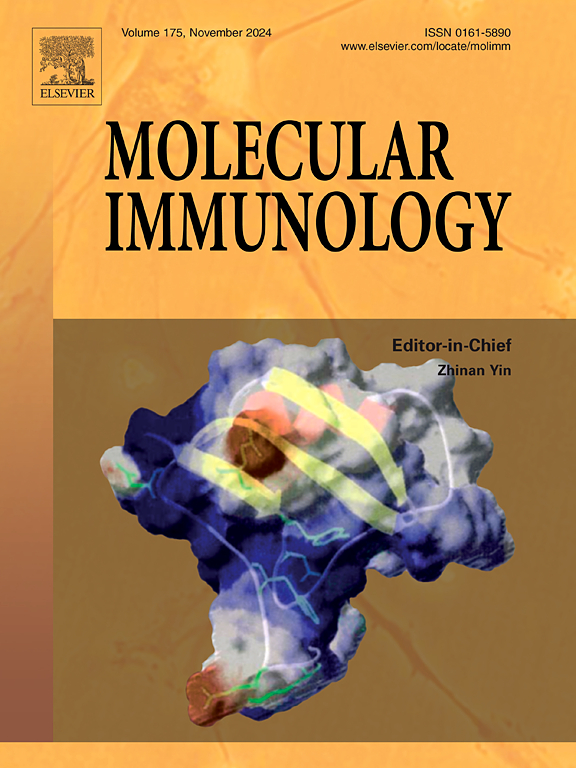巨噬细胞中smad7介导的铁凋亡驱动骨质疏松进展:一项多组学研究
IF 3
3区 医学
Q2 BIOCHEMISTRY & MOLECULAR BIOLOGY
引用次数: 0
摘要
骨质疏松症(Osteoporosis, OP)的特点是骨内平衡失衡,目前的治疗策略难以精确调节。巨噬细胞由于与破骨细胞和成骨细胞的复杂相互作用,在骨重塑中起着重要作用,这表明靶向巨噬细胞相关通路可能提供新的治疗机会。为了探索这一点,我们结合了大量RNA-seq和scRNA-seq数据来鉴定巨噬细胞相关基因。利用生物信息学工具,包括CIBERSORT、WGCNA和机器学习算法,我们鉴定了1705个巨噬细胞标记基因和839个巨噬细胞模块基因。富集分析显示,这些交叉基因在铁下垂信号通路中显著富集,突出了其在巨噬细胞中的关键作用。通过蛋白-蛋白相互作用网络和细胞通讯分析进一步验证了巨噬细胞铁下垂的重要性。利用人工神经网络,我们鉴定出4个巨噬细胞枢纽基因,其中SMAD7的权重最大。RAW264.7细胞实验验证、免疫组织化学和显微ct分析进一步证实了铁中毒相关指标(Fe2 +和脂质过氧化)与骨质疏松症患者骨损伤的相关性。我们发现SMAD7与小梁微结构恶化的相关性最强。值得注意的是,我们的研究结果还证实了SMAD7抑制剂mongersen有效地减轻了巨噬细胞的铁凋亡,这表明它有可能改善骨微结构的完整性。我们的研究表明,SMAD7介导的巨噬细胞铁凋亡是骨质疏松症发病的关键机制,强调SMAD7是一个有前景的治疗靶点。本文章由计算机程序翻译,如有差异,请以英文原文为准。
SMAD7-mediated ferroptosis in macrophages drives osteoporosis progression: A multi-omics study
Osteoporosis (OP) is characterized by imbalanced bone homeostasis, which is difficult to precisely regulate with current therapeutic strategies. Macrophages play a significant role in bone remodeling due to their complex interactions with osteoclasts and osteoblasts, suggesting that targeting macrophage-related pathways could offer novel therapeutic opportunities. To explore this, we combined bulk RNA-seq and scRNA-seq data to identify macrophage-related genes. Using bioinformatic tools, including CIBERSORT, WGCNA, and machine learning algorithms, we identified 1705 macrophage marker genes and 839 macrophage module genes. Enrichment analysis revealed that the intersection genes were significantly enriched in the ferroptosis signaling pathway, highlighting its critical role in macrophages. Further validation through protein-protein interaction networks and cellular communication analysis confirmed the importance of ferroptosis in macrophage. Using artificial neural network, we identified 4 macrophage hub genes, with SMAD7 showing the greatest weight. Experimental validation using RAW264.7 cells, immunohistochemistry, and micro-CT analysis further demonstrated the association of ferroptosis-related indicators (Fe2 + and lipid peroxidation) with bone damage in osteoporosis patients. And we found SMAD7 showing the strongest correlation with trabecular microstructural deterioration. Notably, our findings also confirmed that the SMAD7 inhibitor mongersen effectively attenuated macrophage ferroptosis, suggesting its potential to improve bone microstructural integrity. Our study demonstrates that SMAD7-mediated macrophage ferroptosis is a critical mechanism in osteoporosis pathogenesis, highlighting SMAD7 as a promising therapeutic target.
求助全文
通过发布文献求助,成功后即可免费获取论文全文。
去求助
来源期刊

Molecular immunology
医学-免疫学
CiteScore
6.90
自引率
2.80%
发文量
324
审稿时长
50 days
期刊介绍:
Molecular Immunology publishes original articles, reviews and commentaries on all areas of immunology, with a particular focus on description of cellular, biochemical or genetic mechanisms underlying immunological phenomena. Studies on all model organisms, from invertebrates to humans, are suitable. Examples include, but are not restricted to:
Infection, autoimmunity, transplantation, immunodeficiencies, inflammation and tumor immunology
Mechanisms of induction, regulation and termination of innate and adaptive immunity
Intercellular communication, cooperation and regulation
Intracellular mechanisms of immunity (endocytosis, protein trafficking, pathogen recognition, antigen presentation, etc)
Mechanisms of action of the cells and molecules of the immune system
Structural analysis
Development of the immune system
Comparative immunology and evolution of the immune system
"Omics" studies and bioinformatics
Vaccines, biotechnology and therapeutic manipulation of the immune system (therapeutic antibodies, cytokines, cellular therapies, etc)
Technical developments.
 求助内容:
求助内容: 应助结果提醒方式:
应助结果提醒方式:


